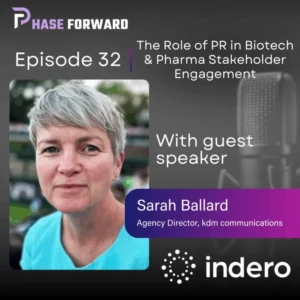Episode 32: Strategic Storytelling: The Role of PR in Biotech & Pharma Stakeholder Engagement
Resources:
- [email protected]: Use this email to let us know what you want to hear about.
- Strategies for Global Clinical Trials: Timelines, Communication, and Resilience
- Kdm-communications.com

In this episode, Sarah Ballard, Agency Director at kdm communications, shares insights from over 20 years of experience in marketing within the scientific, technical, and medical B2B sectors. Renowned for a strategic approach and compassionate leadership, Sarah has guided numerous organizations in crafting effective public relations (PR) and integrated communications campaigns.
The conversation explores how PR influence perception, foster trust, and drive business objectives across diverse stakeholder audiences. Listeners will gain a deeper understanding of PR’s evolving role as a strategic function and its impact on credibility and growth in complex industries.
The Evolving Role of PR
PR has undergone significant evolution, becoming a critical business function rather than remaining on the periphery. This shift is largely driven by today’s always-on, digitally connected landscape. With an overwhelming abundance of information readily available, the challenge lies in cutting through the noise to ensure messages reach the right audience.
Digitalization has transformed communication by enabling instant updates and broad visibility across multiple channels. As a result, brands must maintain consistent messaging and experiences—whether through websites, direct interactions, media coverage, or other communications—to foster familiarity and recognition. Consistency is no longer optional; it is essential.
Moreover, digital platforms have democratized communication, allowing anyone to have a voice. In this environment, trust is no longer assumed—it must be earned and continually reinforced through integrity and authenticity. This makes trust-building a foundational element of any brand strategy.
Today’s stakeholders are more informed and discerning, heightening the importance of storytelling. Effective storytelling now centers not only on what a brand does, but why it does it. Audiences increasingly seek alignment with brands whose values reflect their own, making value-driven communication key to fostering connection and credibility.
PR now serves as the connective tissue between brand, purpose, and trust. As such, it plays an indispensable role in the success of modern businesses.
One additional point worth noting is the increasingly public and fragile nature of brand reputation. With stakeholders now observable in real time, expectations for timely and appropriate responses have risen accordingly. As a result, PR extends beyond growth-focused initiatives to encompass reputation management and risk mitigation. In today’s environment, PR is less about controlling the message and more about shaping a consistent, credible narrative across fragmented, fast-moving channels. This approach is essential to maintaining trust and resilience in a dynamic communications landscape.
PR as a Strategic Business Function
PR must address a diverse range of stakeholders through communication, including the media, customers and prospective customers, investors and shareholders, internal teams, and employees. Additionally, broader organizations such as regulators are important audiences. The breadth of stakeholders requires messaging tailored appropriately to each group to ensure resonance and clarity of the intended communication.
Strategic PR should align closely with business outcomes, whether attracting investment, influencing regulators, or retaining core internal talent. Ultimately, PR builds the trust that underpins all of these objectives.
Storytelling
The narrative also resonates with people, not just reflecting numbers. Effective storytelling connects milestones and strategy to shareholder value by illustrating the broader trajectory, mission, impact, and the team driving progress. It conveys the organization’s direction, the reasons behind its significance, and what progress looks like along the way.
Importantly, the story developed during strong periods acts as a stabilizing force during times of uncertainty, such as leadership changes or clinical trial delays. Providing clarity and reassurance with a clear path forward supports investor confidence. When trust has already been established through consistent, value-driven storytelling, challenges do not require starting from zero. Operating from a foundation of credibility ensures resilience and long-term strength.
Boosting Investor Confidence Through PR
PR provides a structured framework for how, when, and where communication with shareholders takes place, especially during periods of heightened scrutiny. This includes framing complex information clearly and accessibly for the intended audience, preparing leadership for challenging investor calls or press interactions to anticipate and address potential questions, and proactively owning the narrative whenever possible. Such an approach helps avoid uncertainty and encourages confidently stepping into the spotlight.
Future Trends
This discussion began by highlighting trends that have already impacted the industry, particularly digitalization. Artificial intelligence (AI) serves as a key example of a technology advancing this progression. Today’s stakeholders seek communication that feels authentic, human, and value-driven. While AI can be utilized in certain formats, it must be applied in ways that continue to foster trust—trust being the ultimate foundation that is easily lost.
Within communications agencies, AI is often employed as a tool to handle administrative tasks and enable experts to focus on their core strengths. However, all content creation remains human-driven, supported by extensive dialogue with industry experts. The value derived from navigating these conversations and gathering insights cannot be replicated artificially, especially within regulated industries like clinical trials.
Nuances of tone and accuracy in communicating complex information remain critical, and AI has yet to master these subtleties. Human oversight is essential across all community interactions, including those with patients.
Aligning with earlier points on multichannel storytelling, today’s media landscape utilizes podcasts, webinars, videos, written content, and social media to engage audiences. The key takeaway for industry teams is the need for agility and intentionality, functioning more as content curators than mere creators. This involves discerning what to communicate, prioritizing meaningful messages, situating them within a broader narrative, and selecting the most effective channels to deliver them—thus building brand messaging progressively over time.
Choosing the Right PR Partner
Finding the right partner is essential—one that brings insight beyond mere execution. Such a partner provides strategic advice, offers constructive pushback, anticipates challenges, and operates as an extension of the internal team. Authenticity and trust must be evident within these partnerships. Without an intimate understanding of the organization, values cannot be communicated effectively.
The agency positions itself as an extension of clients’ teams and serves as a bridge between clients and the media or editorial community. Significant time is invested in understanding clients deeply. Experience within niche specialist industries has enabled the cultivation of strong relationships with industry press, which represents a key area of value addition.
Final Takeaway
The key takeaway is that PR centers on building long-term trust, visibility, and resilience. In highly regulated, science-driven sectors such as this, PR is not optional but a strategic asset integrated into growth, funding, and engagement strategies from the outset. Organizations that invest in thoughtful, value-aligned storytelling not only capture attention but also build confidence among all essential stakeholders. Strong PR establishes a solid reputation before it is needed and safeguards it when it matters most.
As we conclude another illuminating episode of Phase Forward, we find ourselves at the crossroads of science and progress. Remember that behind the jargon and statistics, lies stories of unwavering commitment, meticulous observation, and the pursuit of evidence that shapes our understanding of health and disease. Stay at the forefront of knowledge and innovation and follow Phase Forward on your preferred platform. My name is Valerie Coveney. Thank you for joining us. Until next time.


